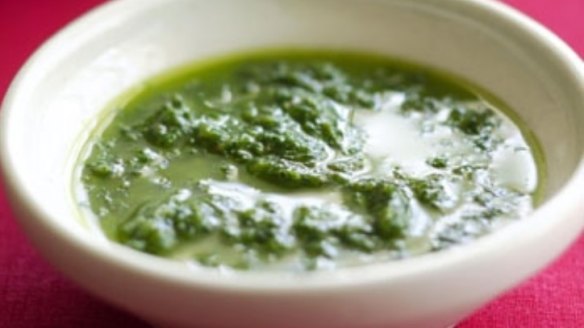This spicy Middle Eastern condiment is finally getting the attention it deserves

The sauce might be red, or green. It might have mint, or jalapeno, or fenugreek, or parsley. It might be called zhug, or zhough, or s'hug, or sahawiq, or daqqus. But it's all the same thing: a spicy Middle Eastern condiment that, at long last, is getting its due in the United States.
Zhug, the Hebrew word for the sauce, and sahawiq, one of the Arabic words for it, originated in Yemen, but it has long been popular throughout the region.

The best thing about it? "It's a nice condiment to have with everything," whether it's meat or bread or vegetables, said Amar Alshehari, who cooks with his father, Abdul, the chef and owner of Arlington, Virginia's House of Mandi. "Whatever you're eating as a main entree."
His family is from Sanaa, Yemen, and the family recipe includes dried and fresh coriander, jalapeno, tomatoes and mint, all ground together.
"Back home, we don't have blenders," Alshehari said, explaining that the word sahawiq comes from the root word for "breaking down." "You use a rock plate and a rock utensil to break down the tomatoes and other ingredients."
There are other riffs on the sauce. At Sababa in Washington, chef Ryan Moore uses an Israeli recipe: equal parts fire-roasted and fresh serrano chilli peppers, lemon juice, garlic, coriander, parsley, cumin and fenugreek leaves. He pairs his zhug with roasted spicy peppers and harissa in a dish called Not for the Faint of Heart. It's meant to be an accompaniment to other foods, but some people eat it plain as a dare.
"They're always trying to best each other to see who can take down the most of it," said Moore.
At Maydan in Washington, where the menu spells it zhough, the sauce is one of seven condiment choices. Co-chef Gerald Addison makes it with parsley, coriander, garlic, serrano peppers, cumin, olive oil and salt. "I like sauces that are super herbaceous, so it fulfilled that need," he said.
Middle Eastern food is on the upswing, with Israeli food one of the year's top trends. Americans' culinary understanding has evolved, with a greater appreciation for regional cuisines from abroad. It's made harissa popular; the fiery red sauce is sold at Trader Joe's, and "you find it in a lot of general new American restaurants," said Addison. Zhug is starting to take hold in fast-casual chains, but it is still up-and-coming.
That may change as people show more interest in Yemeni food, as Alshehari sees happening in Washington because of President Donald Trump's travel ban. "People have started to open their eyes," he said.
The Washington Post
- More:
- Food